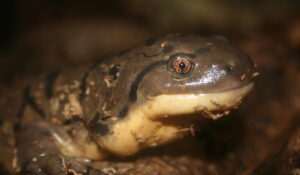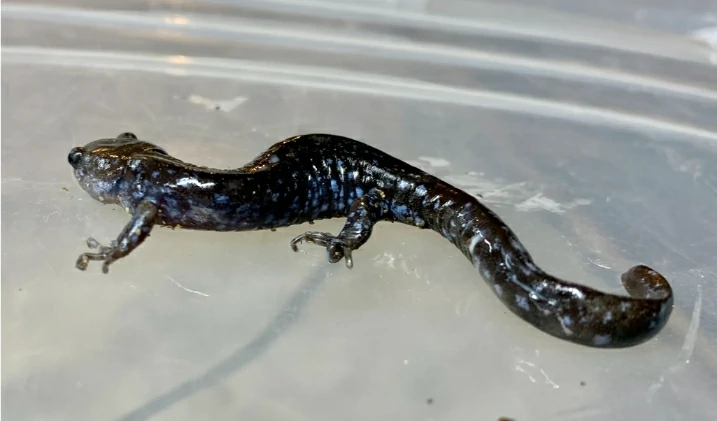Salamanders are quiet, secretive amphibians that move slowly and spend much of their time hidden in damp places. If you’ve ever watched one stalk its prey or sit motionless beneath a log, you might wonder how often it eats. This is a common question among salamander owners and people who observe them in the wild.
Most salamanders eat every few days to once a week, depending on their age, size, activity level, and environment. Juveniles need to eat more often, while adults can go longer between meals. Salamanders in cold conditions may stop eating for weeks at a time.
How Salamanders Eat in the Wild
In nature, salamanders are opportunistic feeders. They do not eat on a strict schedule. Instead, they wait patiently for small prey to come near. When the time is right, they strike quickly.

If prey is easy to find, a salamander may eat several times a week. If conditions are poor or food is scarce, it may go days or even weeks without eating.
Many salamanders also reduce activity during the winter or dry seasons. Some burrow into the ground or hide in damp places and become dormant. While dormant, they do not eat.
This ability to adjust their feeding habits helps salamanders survive in changing environments.
The Role of Temperature in Feeding
Salamanders are cold-blooded animals. This means they do not produce their own body heat. Instead, their body temperature depends on the temperature around them.
As a result, their metabolism rises and falls with the environment.
When the weather is warm, salamanders become more active. Their bodies use energy faster, and they need to eat more often. In cold conditions, their activity slows down. Their appetite decreases, and they may stop eating for long periods.
A salamander that eats every two or three days in summer may only eat once a week (or not at all) during the cooler months. This shift is natural and does not always mean something is wrong.
How Feeding Varies by Species
Not all salamanders eat the same way. Feeding habits can vary depending on the species, size, and environment.

Here are a few examples:
- Tiger salamanders are large and active. In warm weather, they often eat every 2 to 3 days.
- Axolotls are fully aquatic and have a slower metabolism. Most eat 2 to 3 times per week.
- Spotted salamanders tend to feed less often, especially in cooler weather.
- Smaller terrestrial species may need to eat more frequently, but in smaller portions.
Each species has its own rhythm. Learning about your salamander’s natural behavior will help you feed it correctly.
Feeding Juveniles vs. Adults
Young salamanders grow quickly. To support this growth, they need to eat more often than adults. Most juveniles need food every 1 to 2 days. Their meals should be small but regular.
Adult salamanders grow more slowly and use less energy. Most healthy adults eat every 3 to 7 days, depending on their size and how active they are.
Feeding a juvenile too infrequently can lead to poor growth and health issues. Feeding an adult too often can cause it to gain weight and become sluggish.
The key is to adjust feeding frequency as the salamander grows and its needs change.
What Influences a Salamander’s Appetite?
Several factors affect how often a salamander eats. These include:
- Temperature – Warm environments increase activity and appetite. Cold ones reduce both.
- Activity level – A salamander that moves around a lot will need more food than one that is still.
- Season – Feeding often slows down or stops during winter or dry periods.
- Health – A sick or stressed salamander may stop eating.
- Size – Larger salamanders can eat more at once and go longer without food. Smaller ones may need to eat more often.
Understanding these factors helps you create a feeding schedule that matches your salamander’s natural behavior.
Signs a Salamander Is Ready to Eat
Salamanders do not show hunger in obvious ways. They will not beg for food or become loud like dogs or cats. But they do show quiet signs when they are ready to eat.
Look for these behaviors:
- Increased movement near feeding time
- Moving toward the front of the tank or water’s edge
- Watching your hand or following motion
- Eyes that look bright and alert
- Slow, careful investigation of the surroundings
These are all signs that the salamander is interested in food. If your salamander refuses food for more than a week and is not in a dormant state, it may be time to check for possible health issues.
Feeding Pet Salamanders
Pet salamanders need a feeding schedule that reflects their age, species, and environment. Here are some basic guidelines:
- Juveniles – Feed every 1 to 2 days. Offer small, live prey such as earthworms, crickets, or soft-bodied insects.
- Adults – Feed every 3 to 7 days. Larger adults may eat every 3 to 4 days. Smaller ones or aquatic types like axolotls may eat just twice per week.
Always remove uneaten prey after feeding. This keeps the enclosure clean and reduces stress.
It’s also helpful to rotate food types. Offering a variety of insects and worms gives your salamander more nutrients and keeps feeding time more engaging.
Risks of Feeding Too Often or Not Enough
Feeding your salamander too much or too little can lead to health problems.
Overfeeding may cause:
- Weight gain
- Fatty liver disease
- Reduced movement
- Poor water quality in aquatic tanks
Underfeeding may cause:
- Weight loss
- Weakness
- Poor growth in young salamanders
- A weakened immune system
Watch your salamander’s body shape and activity levels. A healthy salamander should be alert, active, and have a smooth, full body, not too thin or bloated.
Brumation and Feeding
Some salamanders enter a state called brumation during colder months. Brumation is similar to hibernation, but not as deep. The salamander becomes still and uses very little energy. It may remain hidden for weeks or even months.
While brumating, salamanders stop eating. This is normal. Their metabolism slows, and they do not need food.
Unlike some species, axolotls do not hibernate but may experience reduced activity in cooler temperatures.

Feeding a brumating salamander can be harmful. Because digestion slows down, any food eaten may not be processed properly and could rot inside the body.
When temperatures rise and the salamander becomes active again, you can slowly start feeding it as usual.
Watching for Feeding Problems
A healthy salamander should have moist skin, clear eyes, and a steady appetite. If your salamander suddenly stops eating, looks thinner, or seems stressed, take a closer look at its environment.
Problems may include:
- Incorrect temperature or humidity
- Dirty water or poor ventilation
- Stress from handling or noise
- Underlying illness or injury
If you cannot find the cause, contact a veterinarian who specializes in amphibians. A small issue can become serious if not addressed early.
Regular feeding and observation help keep your salamander healthy over the long term.
Conclusion
How often do salamanders have to eat? Most salamanders eat every few days to once a week, depending on their species, size, age, and environment.
Juveniles need to eat more often. Adults can go longer between meals.
When it gets cold, salamanders may stop eating altogether.
By paying attention to temperature, activity, and health, you can build a feeding schedule that matches your salamander’s needs.
Hi, my name is Ezra Mushala, i have been interested animals all my life. I am the main author and editor here at snakeinformer.com.

